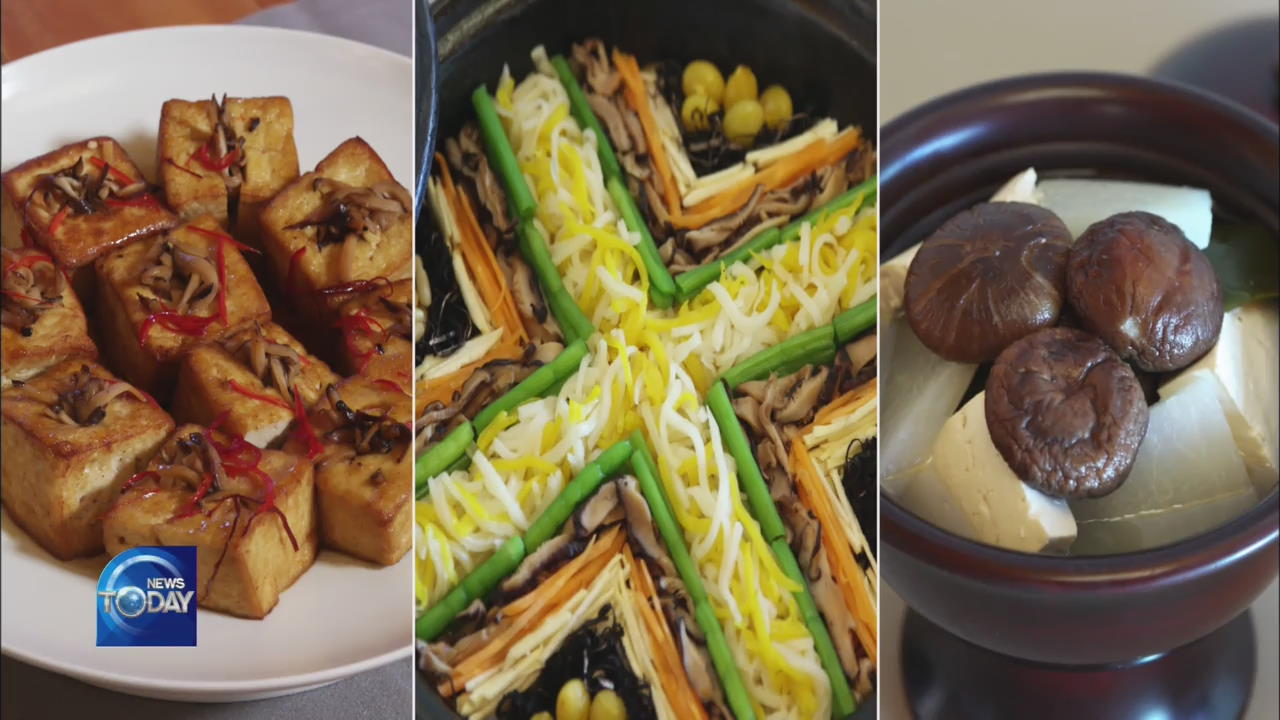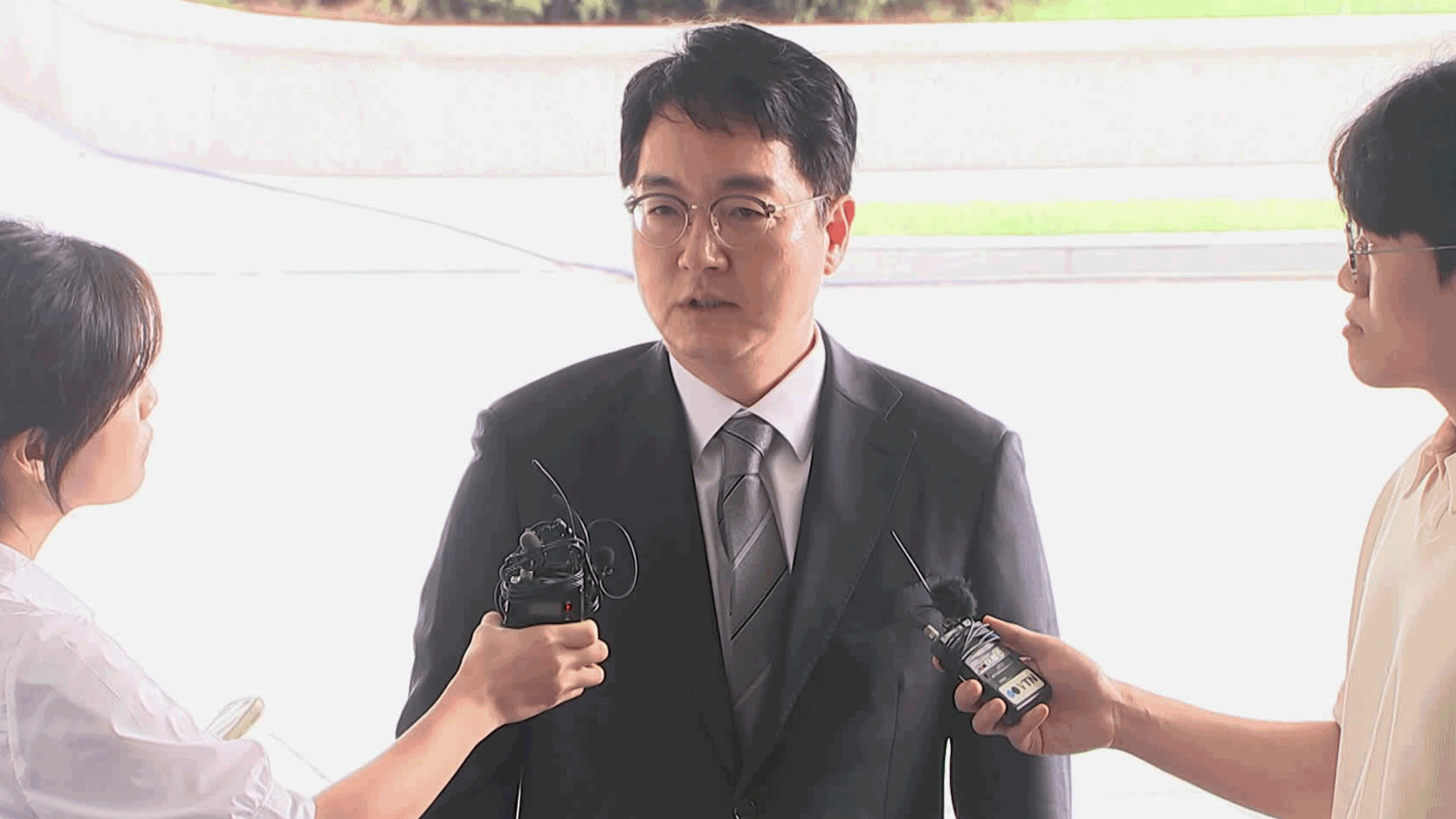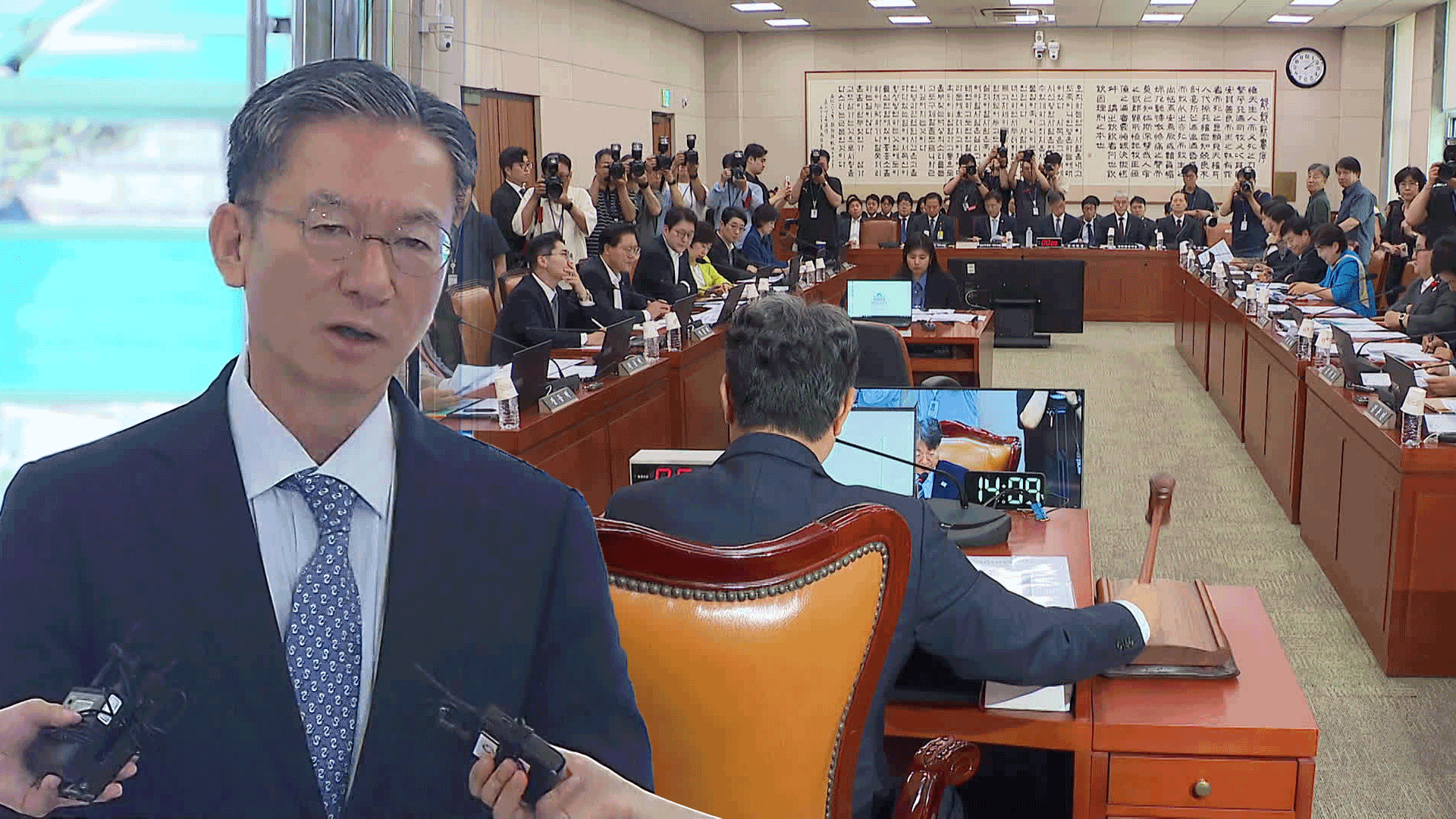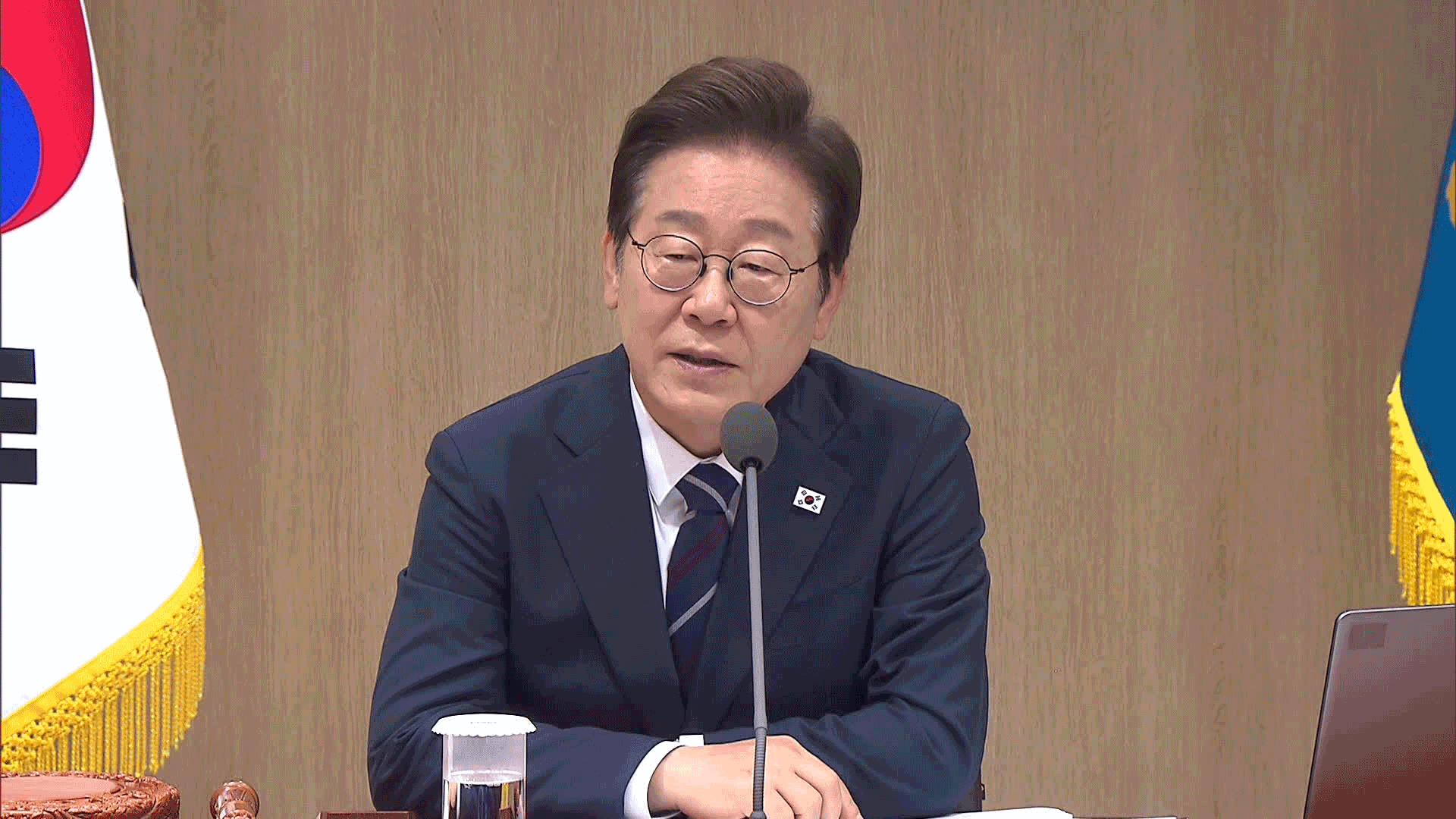KOREAN TOFU DISH
입력 2019.07.19 (15:09)
수정 2019.07.19 (16:45)
읽어주기 기능은 크롬기반의
브라우저에서만 사용하실 수 있습니다.
[Anchor Lead]
Tofu is an ordinary food ingredient used in many dishes. But a tofu dish that first appeared in a Joseon-period document from some 500 years ago is grabbing attention as it is recreated by a renowned chef of temple cuisine. Let's take a look at how it's made and how good it tastes.
[Pkg]
Jingwansa Buddhist temple located at the foot of Bukhansan Mountain. The temple's chief monk has been grinding soybeans to make tofu for over 50 years. She uses the traditional tofu-making
method of boiling finely ground soybean milk in a big cast iron pot and straining the liquid through hemp cloth. She then steams the tofu again before mashing it with her hands. Salt, pepper, and sesame oil are the only seasonings that go into it.
[Soundbite] MONK GYEHO(CHIEF MONK AT JINGWANSA TEMPLE) : "The best seasoning is the heart. So a chef must have a good heart."
Garnishing the tofu with finely sliced manna lichen mushroom, pine nuts and watercress completes the traditional steamed tofu dish called the 'pojeung.'
[Soundbite] "I thought it would taste really bland, but it actually has rich flavors."
Court official Sin Suk-ju wrote in 1463, during King Sejo's reign, that he went to Jingwansa Temple and ate pojeung. Since then, the temple had made tofu for the royal family for nearly 500 years.
[Soundbite] PROF. SHIM SEUNG-KOO(KOREA NATIONAL SPORT UNIV.) : "This documents how tofu was introduced to Korea in the late 14th century and established as a temple food and later spread to the royal court and ordinary households."
From tofu stewed in soy sauce to five-colored tofu stew and clear tofu soup... these are all tofu dishes flavored with minimal seasoning.
[Soundbite] MONK GYEHO(CHIEF MONK AT JINGWANSA TEMPLE) : "The food I eat shapes my body and character. So the food must be mild and simple."
Mild yet rich in flavor, tofu may be a common food ingredient, but it contains several centuries of heritage.
Tofu is an ordinary food ingredient used in many dishes. But a tofu dish that first appeared in a Joseon-period document from some 500 years ago is grabbing attention as it is recreated by a renowned chef of temple cuisine. Let's take a look at how it's made and how good it tastes.
[Pkg]
Jingwansa Buddhist temple located at the foot of Bukhansan Mountain. The temple's chief monk has been grinding soybeans to make tofu for over 50 years. She uses the traditional tofu-making
method of boiling finely ground soybean milk in a big cast iron pot and straining the liquid through hemp cloth. She then steams the tofu again before mashing it with her hands. Salt, pepper, and sesame oil are the only seasonings that go into it.
[Soundbite] MONK GYEHO(CHIEF MONK AT JINGWANSA TEMPLE) : "The best seasoning is the heart. So a chef must have a good heart."
Garnishing the tofu with finely sliced manna lichen mushroom, pine nuts and watercress completes the traditional steamed tofu dish called the 'pojeung.'
[Soundbite] "I thought it would taste really bland, but it actually has rich flavors."
Court official Sin Suk-ju wrote in 1463, during King Sejo's reign, that he went to Jingwansa Temple and ate pojeung. Since then, the temple had made tofu for the royal family for nearly 500 years.
[Soundbite] PROF. SHIM SEUNG-KOO(KOREA NATIONAL SPORT UNIV.) : "This documents how tofu was introduced to Korea in the late 14th century and established as a temple food and later spread to the royal court and ordinary households."
From tofu stewed in soy sauce to five-colored tofu stew and clear tofu soup... these are all tofu dishes flavored with minimal seasoning.
[Soundbite] MONK GYEHO(CHIEF MONK AT JINGWANSA TEMPLE) : "The food I eat shapes my body and character. So the food must be mild and simple."
Mild yet rich in flavor, tofu may be a common food ingredient, but it contains several centuries of heritage.
■ 제보하기
▷ 카카오톡 : 'KBS제보' 검색, 채널 추가
▷ 전화 : 02-781-1234, 4444
▷ 이메일 : kbs1234@kbs.co.kr
▷ 유튜브, 네이버, 카카오에서도 KBS뉴스를 구독해주세요!
- KOREAN TOFU DISH
-
- 입력 2019-07-19 15:02:30
- 수정2019-07-19 16:45:30

[Anchor Lead]
Tofu is an ordinary food ingredient used in many dishes. But a tofu dish that first appeared in a Joseon-period document from some 500 years ago is grabbing attention as it is recreated by a renowned chef of temple cuisine. Let's take a look at how it's made and how good it tastes.
[Pkg]
Jingwansa Buddhist temple located at the foot of Bukhansan Mountain. The temple's chief monk has been grinding soybeans to make tofu for over 50 years. She uses the traditional tofu-making
method of boiling finely ground soybean milk in a big cast iron pot and straining the liquid through hemp cloth. She then steams the tofu again before mashing it with her hands. Salt, pepper, and sesame oil are the only seasonings that go into it.
[Soundbite] MONK GYEHO(CHIEF MONK AT JINGWANSA TEMPLE) : "The best seasoning is the heart. So a chef must have a good heart."
Garnishing the tofu with finely sliced manna lichen mushroom, pine nuts and watercress completes the traditional steamed tofu dish called the 'pojeung.'
[Soundbite] "I thought it would taste really bland, but it actually has rich flavors."
Court official Sin Suk-ju wrote in 1463, during King Sejo's reign, that he went to Jingwansa Temple and ate pojeung. Since then, the temple had made tofu for the royal family for nearly 500 years.
[Soundbite] PROF. SHIM SEUNG-KOO(KOREA NATIONAL SPORT UNIV.) : "This documents how tofu was introduced to Korea in the late 14th century and established as a temple food and later spread to the royal court and ordinary households."
From tofu stewed in soy sauce to five-colored tofu stew and clear tofu soup... these are all tofu dishes flavored with minimal seasoning.
[Soundbite] MONK GYEHO(CHIEF MONK AT JINGWANSA TEMPLE) : "The food I eat shapes my body and character. So the food must be mild and simple."
Mild yet rich in flavor, tofu may be a common food ingredient, but it contains several centuries of heritage.
Tofu is an ordinary food ingredient used in many dishes. But a tofu dish that first appeared in a Joseon-period document from some 500 years ago is grabbing attention as it is recreated by a renowned chef of temple cuisine. Let's take a look at how it's made and how good it tastes.
[Pkg]
Jingwansa Buddhist temple located at the foot of Bukhansan Mountain. The temple's chief monk has been grinding soybeans to make tofu for over 50 years. She uses the traditional tofu-making
method of boiling finely ground soybean milk in a big cast iron pot and straining the liquid through hemp cloth. She then steams the tofu again before mashing it with her hands. Salt, pepper, and sesame oil are the only seasonings that go into it.
[Soundbite] MONK GYEHO(CHIEF MONK AT JINGWANSA TEMPLE) : "The best seasoning is the heart. So a chef must have a good heart."
Garnishing the tofu with finely sliced manna lichen mushroom, pine nuts and watercress completes the traditional steamed tofu dish called the 'pojeung.'
[Soundbite] "I thought it would taste really bland, but it actually has rich flavors."
Court official Sin Suk-ju wrote in 1463, during King Sejo's reign, that he went to Jingwansa Temple and ate pojeung. Since then, the temple had made tofu for the royal family for nearly 500 years.
[Soundbite] PROF. SHIM SEUNG-KOO(KOREA NATIONAL SPORT UNIV.) : "This documents how tofu was introduced to Korea in the late 14th century and established as a temple food and later spread to the royal court and ordinary households."
From tofu stewed in soy sauce to five-colored tofu stew and clear tofu soup... these are all tofu dishes flavored with minimal seasoning.
[Soundbite] MONK GYEHO(CHIEF MONK AT JINGWANSA TEMPLE) : "The food I eat shapes my body and character. So the food must be mild and simple."
Mild yet rich in flavor, tofu may be a common food ingredient, but it contains several centuries of heritage.
이 기사가 좋으셨다면
-
좋아요
0
-
응원해요
0
-
후속 원해요
0














![[단독] 골프연습장 아니라더니<br>…‘한남동 골프연습장’ 도면 입수](/data/news/2025/07/01/20250701_Uh8Jnu.png)


이 기사에 대한 의견을 남겨주세요.